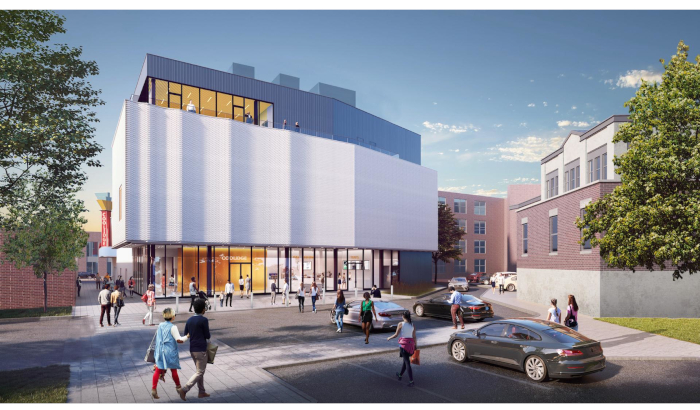
The iconic Brookline theater strives to unite the local film community with its $12.5 million expansion
On a muggy summer day, a large group of excited moviegoers waits outside the Coolidge Corner Theatre for Ousmane Sembène’s 1966 drama Black Girl. At 7 p.m., everyone settles into the cinema’s red and gold 432-seat main theater. Anticipation builds. There are murmurs and some loud popcorn chewing. Soon the lights dim and the red velvet curtains open. It’s showtime.
Black Girl, which received acclaim for its critique of the colonialist mind-set of a supposedly postcolonial world, is part of Coolidge’s 2022 Big Screen Classics series. This year’s theme is “groundbreaking,” a nod to the start of construction on the theater’s new wing. Titles are often shown on 35mm or are new restorations projected in the Coolidge’s biggest theaters. Classics like Labyrinth, The Big Lebowski, and Mad Max: Fury Road will be shown this summer at the iconic theater.
Campaign for the Coolidge, the $12.5 million operation supporting the 14,000-square foot addition that complements the four existing theaters, was announced last June. The expansion includes two new screens (150 and 57 seats), an expanded glass-walled lobby, and a new community education and engagement center. The theater’s main entrance will also be moved to the Centre Street parking lot at the back of the building, giving moviegoers more space to socialize inside before screenings.
Designed by architects Höweler + Yoon, the revamped area will embrace a 21st-century approach to art deco while respecting the iconic marquee built in 1933. “We want the expansion to be a more modern interpretation of our existing art deco,” says Katherine Tallman, executive director of the Coolidge Corner Theatre Foundation. Construction commenced in November 2021 and is expected to take 12 to 13 months to complete.
The theater’s passionate community mainly funded the campaign. Around 700 donors have helped the theater reach 90 percent of its goal. With pandemic-related losses and the cost of expenses on the rise, the campaign enables the theater “to expand its robust audience and increase revenue,” says Stephanie Gozali, associate director of development.
This isn’t the first time the Coolidge community has come to the theater’s rescue. In 1988, local film teacher David Kleiler started a movement to save the cinema after it was sold to a developer who planned to demolish the building or convert it into an office space. Kleiler’s group, “Friends of the Coolidge,” launched a campaign to raise the $2.6 million needed to purchase the building from the developer.
Gozali believes the expansion will help grow the local film community. “We’re not like your typical AMC or Regal theaters. We don’t just show blockbuster movies—we want to use these new theaters to show more documentaries and international films,” says Gozali. “We are different in what we do—we are a community center.”
The engagement center, which will include a 60-seat classroom, allows the Coolidge to expand its educational offerings to learners. Tallman says the center’s goal is to educate, bring people together, and show people other parts of the world through film.
“In Ireland, people have a pub to go to,” she says, “and in Brookline, people have the Coolidge.”
